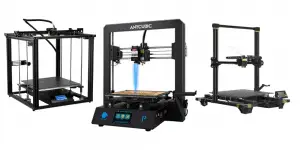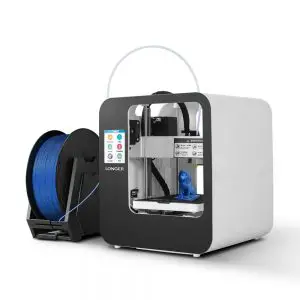3D Printing Shrinkage Compensation
When it comes down to it, there are three types of filament used in 3D printing that are the most popular. These materials are PLA, ABS, and Nylon. Each of them having their own unique properties that make them suitable for some projects over others. ABS, for instance, is strong, impact-resistant, semi-flexible, heat resistant and durable. PLA is biodegradable, less impact-resistant than ABS and available in a wide variety of colors. Nylon is also flexible and has an impressive strength to weight ratio. In a similar way that all three materials are different. When it comes to physical properties, they all undergo varying degrees of shrinkage during production. This shrinkage is a direct result of the transition from a liquid to a solid-state during the curing process. Depending on the material, there can also be an increase in shrinkage based on the temperature of the environment. For example, an enclosed 3D printer versus one that is not. Many 3D printers have amazing features that allow the user to compensate for the shrinkage of material, but, this is not true for all models. This is usually set by the machine which often automatically makes adjustments depending on the material. In which case, there may be several calculations and calibrations happening while the user is completely unaware.
How much does PLA shrink?
Also known as polylactic acid or polylactide, PLA is a very versatile material. PLA is made up of biodegradable materials such as corn, sugarcane, sugar beet pulp and more. Not only is it biodegradable and flexible it is also available in a wide range of colors. Even with that behind said, it is still prone to shrinking during 3D printing. On average you’ll find that the shrinkage rate of PLA somewhere between 2.0-2.5 percent. When compared to the equally popular ABS filament this number is much lower.
How much does nylon shrink?
While ABS and PLA are among the most popular filament types, Nylon does not trail too far behind. Nylon is a fantastic material for 3D printing. It’s a great material to use when printing parts, functional prototypes, 3D printed tools. Nylon is also often used in designing aerospace designs, prototypes, and similar applications. Nylon’s flexibility, durability, strength, and resistance to humidity make it a great material for many users. The shrinkage rate of nylon is approximately 1.7 percent making it lower than both PLA and ABS filaments.
How much does ABS shrink?

ABS is an acronym for acrylonitrile butadiene styrene. ABS is a very versatile material to use and 3D printing. Some features that set ABS apart from other filaments include heat resistance, impact resistance, and durability. You’ll find that ABS filament is used in many applications. From mobile phone cases, inside vehicles, and appliances. In 3D printing, ABS must be heated to a temperature between 230 degrees Celsius and 260 degrees Celsius in order to create objects. While ABS filament is a very strong material, it does have some drawbacks. For instance, ABS does shrink somewhat when it comes in contact with air during the printing process. For this reason, it is highly recommended to use a 3D printer that has a heated bed. A 3D printer that has an enclosure is an even better option to help reduce shrinkage and warping from occurring. The shrinkage rate of ABS filament can be over 8 percent.
Does Shrinkage cause a problem in 3D Printing?
There are a lot of things that go on during the 3D printing process. There are times where shrinkage is not generally an issue and other times when it can be a big deal. When the size of the object is crucial, material shrinkage can become more of a problem and must be taken more seriously. For instance, when 3D printing an item such as a phone case the dimensions and size of the end product must be spot on. Otherwise, the case will not fit the model of the phone it was intended for. When completing projects that must have accurately sized products, the amount of shrinkage must be compensated for.
How to Compensate for Shrinkage in 3D Printing?
It is well established that some form of shrinkage often occurs during the 3D printing process. For this reason, users must take the material being used into consideration when looking for a desired end product or result. If the object being produced must be the exact size and dimensions in order to fit into another piece or product extra care must be taken. The actions that the user may take to ensure a great result largely depends on the type of material being used. As stated above, each material is prone to varying levels of shrinkage.
Shrinkage Compensation for ABS

What are the interesting things about ABS filament is that it shrinks uniformly. This means that the entire object itself will shrink down in size. A common and often frustrating issue with ABS is when warping occurs. This usually occurs when there is a problem during the printing process. There can be several contributing factors however, improper cooling is usually the issue. No matter the reason the end result will be deformed, cracked or a failed print. This Usually happens when materials cool down too rapidly or when the temperature in the environment is unstable. Objects being printed is too close to a vent that is blowing either cool or warm air is often the culprit. Since the shrinkage rate of ABS filament is 8 percent or more, manufacturers have created printers with heated print beds and enclosures. Keeping the print bed warm reduces warping during the printing process. The enclosure ensures a stable temperature throughout the entire process. A printer with a heated bed is a must when using ABS while an enclosure is optional. However, it is highly recommended to use an enclosed printer for optimal results.
Shrinkage Compensation for PLA and Nylon
While the shrinkage rate for PLA is between 2.0-2.5 percent and 1.7 percent for Nylon, you will still have to take this into consideration for both. You won’t have to worry about using an enclosed printer but you may want to upscale your designs to compensate for the possibility of shrinkage. As a result, the dimensional accuracy of the final print can be between plus or minus 1 percent.
Summary
Taking shrinkage into consideration during the 3D printing process can be complicated, but it doesn’t have to be. While it is something that can be a big deal for some prints, for most it won’t be a factor at all. The secret to reducing the impact of shrinkage is to always use enclosed 3D printers with ABS and when necessary scale-up PLA and Nylon designs. If you can do that, you can print anything.




